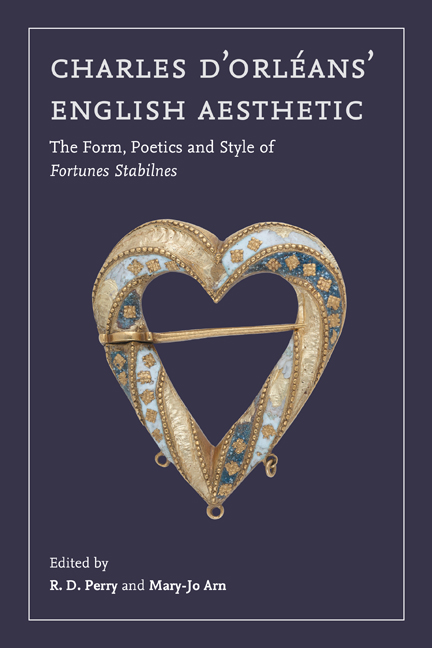Book contents
- Frontmatter
- Dedication
- Contents
- List of Illustrations
- List of Contributors
- Acknowledgements
- Abbreviations
- Introduction
- 1 The Two Dreams of Charles d’Orléans and the Structure of His English Book
- 2 Charles d’Orléans’ Cross-Channel Poetics: The Choice of Ballade Form in Fortunes Stabilnes
- 3 The English Roundel, Charles’s Jubilee, and Mimetic Form
- 4 A Grieving Lover: The Work of Mourning in Charles’s First Ballade Sequence
- 5 Charles d’Orléans’ English Metrical Phonology
- 6 The English Poetry of a Frenchman: Stress and Idiomaticity in Charles d’Orléans
- 7 Verb Use in Charles d’Orléans’ English
- 8 Charles d’Orléans and His Finding of English
- 9 Aureation as Agon: Charles d'Orléans versus John Lydgate
- 10 Charles d’Orléans, Harley 682, and the London Book-Trade
- 11 The Form of the Whole
- Select Publications, 2007–2020
- Index
Introduction
Published online by Cambridge University Press: 14 October 2020
- Frontmatter
- Dedication
- Contents
- List of Illustrations
- List of Contributors
- Acknowledgements
- Abbreviations
- Introduction
- 1 The Two Dreams of Charles d’Orléans and the Structure of His English Book
- 2 Charles d’Orléans’ Cross-Channel Poetics: The Choice of Ballade Form in Fortunes Stabilnes
- 3 The English Roundel, Charles’s Jubilee, and Mimetic Form
- 4 A Grieving Lover: The Work of Mourning in Charles’s First Ballade Sequence
- 5 Charles d’Orléans’ English Metrical Phonology
- 6 The English Poetry of a Frenchman: Stress and Idiomaticity in Charles d’Orléans
- 7 Verb Use in Charles d’Orléans’ English
- 8 Charles d’Orléans and His Finding of English
- 9 Aureation as Agon: Charles d'Orléans versus John Lydgate
- 10 Charles d’Orléans, Harley 682, and the London Book-Trade
- 11 The Form of the Whole
- Select Publications, 2007–2020
- Index
Summary
After the English victory at Agincourt in 1415 one of the greatest French poets of his generation would spend a number of years writing English poetry. Just under a month shy of his twenty-first birthday, Charles, duc d’Orléans, was captured by the English army, the highest-ranking prisoner they would take. He would spend the next twenty-five years as a captive in England, raising his own enormous ransom and that of his brother, Jean d’Angloulême, attempting to negotiate a peace between France and England, and composing poetry in both English and French. When he returned to France in 1440 at the age of forty-six years, a new marriage to Marie of Clèves, three children – including one who would become Louis XII, of France – and twenty-five more years of poetic creation and artistic patronage still lay ahead. Charles's life is fascinating enough, full of romance and intrigue, and it is no wonder that it has been so appealing to biographers, historians, and literary critics. This volume, though, focuses on just one particular aspect of that life: the English poetry Charles left behind him when he returned to France, now largely extant in London, British Library MS Harley 682, with a few additional manuscript leaves and poems copied elsewhere. The contributions collected here reassess Charles's work in relation to its fifteenth-century context and detail those qualities that make the work what it is: Charles's use of English, his metrical play, his felicity with formes fixes lyrics, his innovative use of the dit structure and lyric sequences, and, finally, above all, his ability to write beautiful poetry. The chapters in this volume, moreover, attest to the fact that these qualities are related, that the aesthetic qualities of Charles’s poetry are precisely those features that demonstrate his importance to fifteenth-century English literature. Here I will detail that relationship briefly, outlining the important place Charles holds in fifteenth-century literary culture – considering why, despite that place, his work has not attracted as much scholarly attention as that of his contemporaries – describing what a focus on form can add to our understanding of him, and, finally, thinking through what his French origin might mean for his English work.
- Type
- Chapter
- Information
- Charles d’Orléans' English AestheticThe Form, Poetics, and Style of Fortunes Stabilnes, pp. 1 - 21Publisher: Boydell & BrewerPrint publication year: 2020

